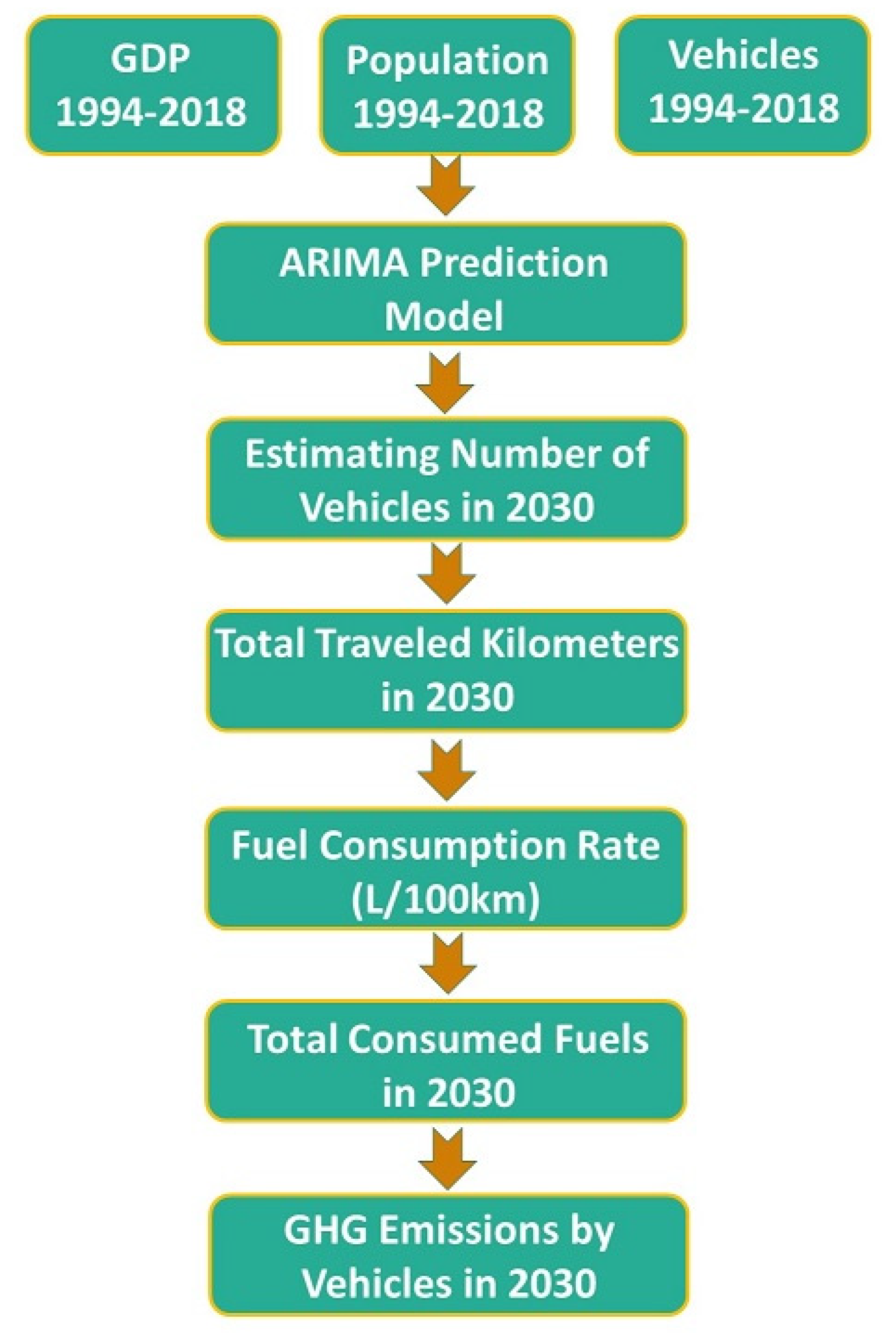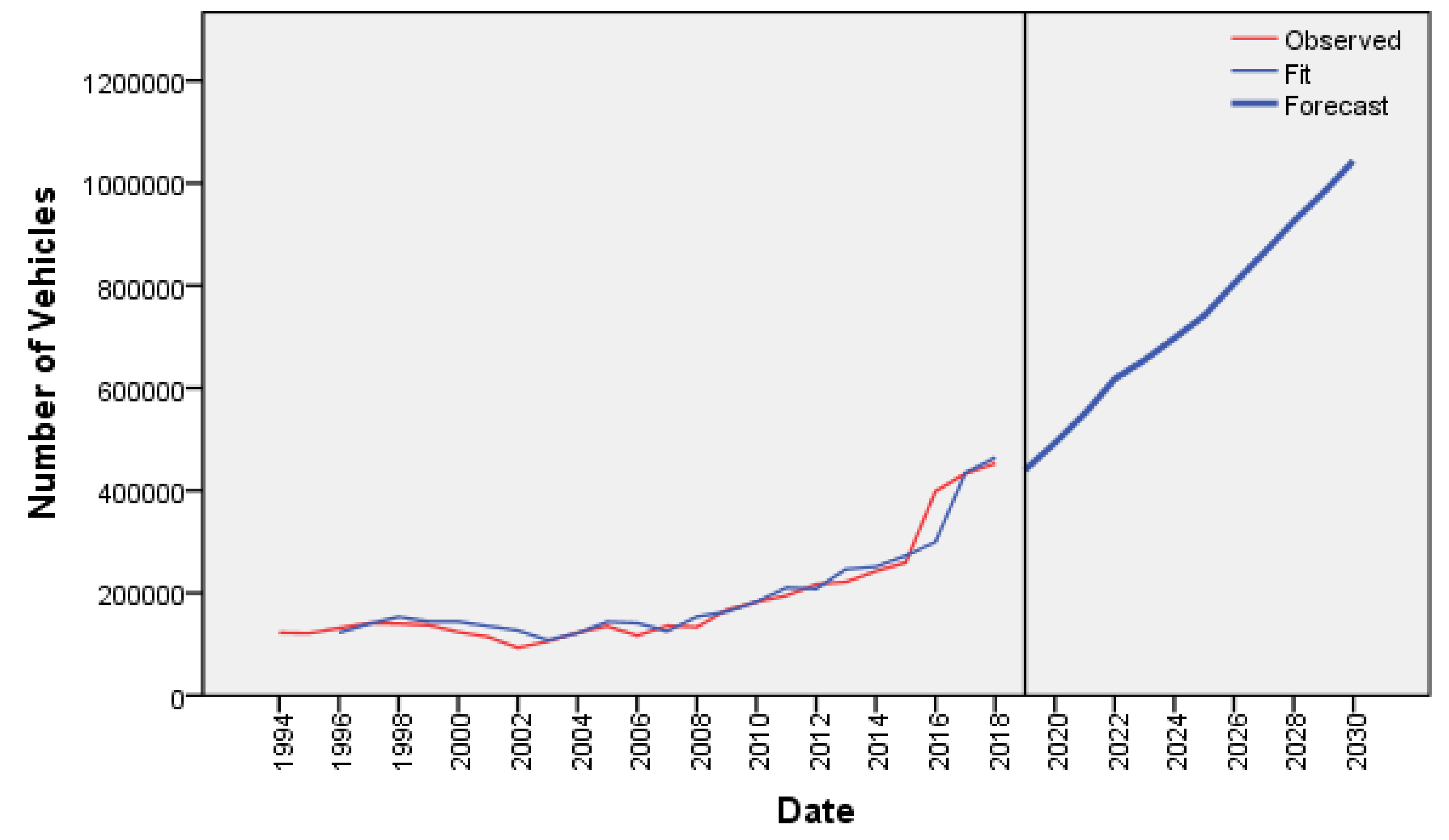Environmental Impact Assessment of the Transportation Sector and Hybrid Vehicle Implications in Palestine
Abstract
1. Introduction
- Scenario 1: 10% hybrid vehicles;
- Scenario 2: 20% hybrid vehicles.
2. Methodology
2.1. Number of Vehicles Prediction Model
- -
- Augmented Dickey–Fuller (ADF) test has been performed to check the stationarity of the time series, as recommended by Din [18].
- -
- Mean absolute error (MAE) has been used in order to select the best-fit model. The model with the lowest values of MAE has been selected, as recommended by Mwenda et al. [19].
- -
- Ljung–Box test has been applied in order to determine the normality of the residuals for the selected model. Moreover, the Shapiro–Wilk test has been used in order to confirm that the residuals follow the normal distribution.
2.2. GHG Emissions by Vehicles in 2020
2.3. GHG Emissions and Implication of Hybrid Vehicles in 2030
3. Results
3.1. Number of Predicted Vehicles
- Yt is the number of vehicles at time (year) t.
- Yt−1, Yt−2, and Yt−3 are the number of vehicles at time lag t − 1, lag t − 2, and lag t − 3.
- εt−1 and εt−2 are the error terms at time t − 1 and t − 2.
- Vt is the population of Palestine (1000) at time (year) t.
- Zt is the gross domestic product of Palestine at time (year) t.
3.2. Estimating GHG Emissions by Vehicles in 2020
3.3. Estimating GHG Emissions by Vehicles in 2030
4. Discussion and Conclusions
- In Palestine, the hybrid vehicle seems to be the best alternative to ICEVs, while the electric vehicles are expected to be kept close to 0% due to the mountainous topography and the weather conditions (air-conditioning and ventilation requirement). The absence of EV electricity charging infrastructure and the instability of the electricity networks and loads affect negatively on the reliability and range of the EVs. Moreover, due to the high portion of coal and fossil fuel-based electricity in Palestine, which is more than 63% of the total source of electricity, EV is not the preferable choice for decision makers due to an insignificant reduction in GHG emissions by EVs compared to ICEVs in this case.
- The estimated CO2, N2O, and CH4 emissions from transportation in 2020 are very high; much higher than the total national emissions reported in 2014. As an example, the total CO2 national emissions (including transportation, industry, communication, etc.) in 2014 were 3,180,300 tons, while the estimated CO2 emissions from the transportation sector in 2020 are 4,842,164.5 tons. Furthermore, a huge increase in the estimated CO2 emissions from the transportation sector is expected in 2030 compared to 2020.
- On the one hand, replacing 20% of ICEVs by hybrid vehicles in 2030 would lead to reductions in CO2 and N2O as compared to using 100% ICEVs (no hybrid vehicles). However, there is also an expected increase in the amount of CH4 since the use of gasoline will increase at the expense of using diesel; the combustion of gasoline produces more CH4 than the diesel combustion.
- The results of this study would promote the introduction of hybrid vehicles in the local market, and would encourage policy and decision makers to set policies to encourage their use; for example, through tax incentives. Furthermore, this study would pave the road for future comprehensive studies and would be a step towards a sustainable transportation system.
- It is recommended to consider PM10, CO, and SOx emissions in any future environmental assessment for the transportation sector in Palestine.
Author Contributions
Funding
Conflicts of Interest
References
- Kapustin, A.; Rakov, V. Methodology to Evaluate the Impact of Hybrid Cars Engine Type on their Economic Efficiency and Environmental Safety. Transp. Res. Procedia 2017, 20, 247–253. [Google Scholar] [CrossRef]
- Lang, J.; Cheng, S.; Zhou, Y.; Zhao, B.; Wang, H.; Zhang, S. Energy and Environmental Implications of Hybrid and Electric Vehicles in China. Energies 2013, 6, 2663–2685. [Google Scholar] [CrossRef]
- Khan, M.; Kar, N.C. Hybrid Electric Vehicles for Sustainable Transportation: A Canadian Perspective. World Electr. Veh. J. 2009, 3, 551–562. [Google Scholar] [CrossRef]
- Trentadue, G.; Garcia, M.; Carriero, M.C.; Valverde, V.; Martini, M. On-Road Emissions and Energy Efficiency Assessment of a Plug-in Hybrid Electric Vehicle (Tech. No. EUR 28985 EN); European Commissions: Luxembourg, 2019. [Google Scholar] [CrossRef]
- Hassouna, F.M.; Al-Sahili, K. Future Energy and Environmental Implications of Electric Vehicles in Palestine. Sustainability 2020, 12, 5515. [Google Scholar] [CrossRef]
- Lorentzen, E.; Haugneland, P.; Bu, C.; Hauge, E. Charging infrastructure experiences in Norway—the worlds most advanced EV. In Proceedings of the EVS30 Symposium, Stuttgart, Germany, 9–11 October 2017. [Google Scholar]
- Foley, A.M.; Winning, I.J.; Gallachoir, B.P. State-of-the-art in electric vehicle charging infrastructure. In Proceedings of the 2010 IEEE Vehicle Power and Propulsion Conference, Lille, France, 1–3 September 2010. [Google Scholar] [CrossRef]
- Macioszek, E. E-mobility infrastructure in the Górnośląsko-Zagłębiowska Metropolis, Poland, and potential for development. In Proceedings of the 5th World Congress on New Technologies (NewTech’19), Lisbon, Portugal, 18–20 August 2019; Paper No. ICERT 108. pp. ICERT 108-1–ICERT 108-4. [Google Scholar] [CrossRef]
- Kato, H.; Ando, R.; Kachi, N. Potential of Plug-in Hybrid Vehicle to Reduce CO2 Emission Estimated from Probe Car Data in Japan. World Electr. Veh. J. 2012, 5, 771–776. [Google Scholar] [CrossRef]
- Pitanuwat, S.; Sripakagorn, A. An Investigation of Fuel Economy Potential of Hybrid Vehicles under Real-World Driving Conditions in Bangkok. Energy Procedia 2015, 79, 1046–1053. [Google Scholar] [CrossRef]
- Mitropoulos, L.K.; Prevedouros, P.D.; Kopelias, P. Total cost of ownership and externalities of conventional, hybrid and electric vehicle. Transp. Res. Procedia 2017, 24, 267–274. [Google Scholar] [CrossRef]
- Palestinian Central Bureau of Statistics. Gas Emissions Statistics in Palestine; Palestinian Central Bureau of Statistics; Palestinian Central Bureau of Statistics: Ramallah, Palestine, 2019. [Google Scholar]
- Palestinian Central Bureau of Statistics. Gas Emissions Statistics in Palestine; Palestinian Central Bureau of Statistics; Palestinian Central Bureau of Statistics: Ramallah, Palestine, 2014. [Google Scholar]
- Palestinian Central Bureau of Statistics. Gas Emissions Statistics in Palestine; Palestinian Central Bureau of Statistics; Palestinian Central Bureau of Statistics: Ramallah, Palestine, 2018. [Google Scholar]
- Stellwagen, E.Y.; Tashman, L. ARIMA: The Models of Box and Jenkins. Foresight Int. J. Appl. Forecast. 2013, 30, 28–33. [Google Scholar]
- Hassouna, F.M.; Abu-Eisheh, S.; Al-Sahili, K. Analysis and Modeling of Road Crash Trends in Palestine. Arab. J. Sci. Eng. 2020, 45, 25–37. [Google Scholar] [CrossRef]
- Hassouna, F.M.; Pringle, I. Analysis and Prediction of Crash Fatalities in Australia. Open Transp. J. 2019, 13, 134–140. [Google Scholar] [CrossRef]
- Din, M.A. ARIMA by Box Jenkins Methodology for Estimation and Forecasting Models in Higher Education. In Proceedings of the ATINER’s Conference Paper Series, Athens, Greece, 17–18 December 2015; pp. 3–14. [Google Scholar] [CrossRef]
- Mwenda, A.; Kuznetsov, D.; Mirau, S. Mathematical Theory and Modeling Time Series Forecasting of Solid Waste Generation in Arusha City-Tanzania. Math. Theory Modeling 2014, 4, 2224–5804. [Google Scholar]
- Mohammad, R.; Santoso, I.B. Prediction of CO, CO2, CH4, and N2O Vehicle Emissions from Environmental Impact Assessment (EIA) at Toll Road of Krian-Legundi-Bunder in East Java of Indonesia. Int. J. Chemtech 2016, 9, 653–664. [Google Scholar]
- Fuel Consumption Report (Rep.). Ottawa: Natural Resources Canada. 2020. Available online: https://fcr-ccc.nrcan-rncan.gc.ca/en#VehicleReport/24452 (accessed on 17 July 2020).




| Model | Number of Predictors | Model Fit Statistics | ||
|---|---|---|---|---|
| Stationary R-Squared | R-Squared | MAE | ||
| (3,2,2) | 2 | 0.701 | 0.955 | 14,709.581 |
| (3,2,1) | 2 | 0.680 | 0.955 | 14,747.995 |
| (0,2,3) | 2 | 0.679 | 0.955 | 15,320.930 |
| (2,2,2) | 2 | 0.504 | 0.931 | 15,663.812 |
| (0,2,2) | 2 | 0.546 | 0.937 | 15,750.507 |
| (1,2,2) | 2 | 0.539 | 0.936 | 16,173.592 |
| (1,2,3) | 2 | 0.574 | 0.941 | 16,266.604 |
| (1,2,1) | 2 | 0.560 | 0.939 | 16,287.114 |
| (2,2,1) | 2 | 0.599 | 0.944 | 16,401.343 |
| (2,2,3) | 2 | 0.590 | 0.943 | 16,415.115 |
| (0,2,1) | 2 | 0.538 | 0.936 | 16,695.548 |
| (3,2,0) | 2 | 0.504 | 0.931 | 17,697.454 |
| (2,2,0) | 2 | 0.366 | 0.912 | 18,994.078 |
| (1,2,0) | 2 | 0.259 | 0.897 | 20,228.233 |
| Gas Emissions | Diesel ICEVs | Gasoline ICEVs | Total | Total GHG (tons of CO2-Equivalent) |
|---|---|---|---|---|
| CO2 (ton) | 3,401,541.704 | 1,440,622.830 | 4,842,164.534 | 4,917,021.907 |
| N2O (ton) | 186.074 | 27.727 | 213.801 | |
| CH4 (ton) | 46.518 | 399.269 | 445.787 |
| Year | Number of Vehicles | Total Traveled-Kilometers (million km) | ICEVs Fuel Consumption Rate (L/km) | Hybrid Fuel Consumption Rate (L/km) | ||
|---|---|---|---|---|---|---|
| Diesel | Gasoline | Diesel | Gasoline | Gasoline | ||
| 2020 | 492,913 | 9015.230 | 5182.590 | 0.129 | 0.107 | 0.0551 |
| 2030 | 1,042,999 | 19,076.227 | 10,966.361 | 0.110 | 0.091 | 0.0441 |
| Scenarios | Total Diesel Consumption (million liter) | Total Gasoline Consumption (million liter) | GHG Emissions (ton) | Total GHG (ton of CO2- Equivalent) | |||
|---|---|---|---|---|---|---|---|
| Diesel (ICEV) | Gasoline (ICEV + Hybrid) | Total | |||||
| Scenario 0 (100% ICEVs + 0% Hybrid) | 2091.71 | 997.39 | CO2 | 611,8042.58 | 2,591,115.54 | 8,709,158.12 | 8,843,796.04 |
| N2O | 334.67 | 49.87 | 384.54 | ||||
| CH4 | 83.67 | 718.13 | 801.80 | ||||
| Scenario 1 (90% ICEVs + 10% Hybrid) | 1882.54 | 1154.82 | CO2 | 5,506,241.25 | 3,000,072.20 | 8,506,313.45 | 8,635,949.8 |
| N2O | 301.21 | 57.74 | 358.95 | ||||
| CH4 | 75.30 | 831.47 | 906.77 | ||||
| Scenario 2 (80% ICEVs + 20% Hybrid) | 1673.37 | 1312.24 | CO2 | 4,894,439.90 | 3,409,028.93 | 8,303,468.83 | 8,428,100.63 |
| N2O | 267.74 | 65.61 | 333.35 | ||||
| CH4 | 66.93 | 944.81 | 1011.74 | ||||
© 2020 by the authors. Licensee MDPI, Basel, Switzerland. This article is an open access article distributed under the terms and conditions of the Creative Commons Attribution (CC BY) license (http://creativecommons.org/licenses/by/4.0/).
Share and Cite
Hassouna, F.M.A.; Al-Sahili, K. Environmental Impact Assessment of the Transportation Sector and Hybrid Vehicle Implications in Palestine. Sustainability 2020, 12, 7878. https://doi.org/10.3390/su12197878
Hassouna FMA, Al-Sahili K. Environmental Impact Assessment of the Transportation Sector and Hybrid Vehicle Implications in Palestine. Sustainability. 2020; 12(19):7878. https://doi.org/10.3390/su12197878
Chicago/Turabian StyleHassouna, Fady M. A, and Khaled Al-Sahili. 2020. "Environmental Impact Assessment of the Transportation Sector and Hybrid Vehicle Implications in Palestine" Sustainability 12, no. 19: 7878. https://doi.org/10.3390/su12197878
APA StyleHassouna, F. M. A., & Al-Sahili, K. (2020). Environmental Impact Assessment of the Transportation Sector and Hybrid Vehicle Implications in Palestine. Sustainability, 12(19), 7878. https://doi.org/10.3390/su12197878






